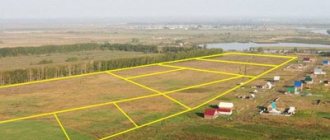Home / Real estate / Land
Back
Published: 11/16/2017
Reading time: 8 min
0
634
The formation of land plots occurs from undemarcated lands or existing plots. The procedure differs, but the requirements for the sites remain the same.
A land plot is a part of the earth's surface that has certain boundaries. The formation of a site is the emergence of a new one as an independent object. This process has a certain order and rules.
- Formation of land from lands
- Ways of education
- Procedure for formation of cadastral works
- Protocol for the formation of land plots
Characteristics of methods for forming land plots
The general reasons for the formation of new areas can be divided into two groups:
- 1) Formation of a new site by changing the physical and legal status of existing sites;
- 2) Formation of a new plot by forming a new real estate object from territories that do not have the characteristics and properties of a land plot.
Based on these reasons, we can identify the main ways of creating new plots of land:
- 1) Division of an existing site into several new ones;
- 2) Consolidation of existing plots into one new one;
- 3) Redistribution of existing land plots with the formation of new ones;
- 4) Allocation from an existing site;
- 5) Formation of a new plot from land owned by state or municipal property.
When existing plots are divided or merged, their physical and legal status is completely lost, and new unique real estate objects appear in their place.
When separated or consolidated, the original parcels retain their existence with a change in physical and legal status. The newly formed plots retain the rights and encumbrances (restrictions) established in relation to the original plots, unless otherwise established by the terms of the agreement of the parties or regulations.
Do you need the help of a lawyer in land matters?
We will advise you on all your questions!
+7
Requirements for created or changed land plots
The formation of a land plot is the creation of a new real estate object as a result of:
- transformation of existing land plots by dividing them, merging them, redistributing them or separating a new land plot from them;
Read more…
The Land Code of the Russian Federation establishes the following methods for converting land plots ( clause 1 of Article 11.2 of the Land Code of the Russian Federation ):
- division of land. In this case, several land plots are formed from one land plot. In this case, as a general rule, the original site ceases to exist. However, in some cases it remains within modified boundaries. For example, when dividing a public land plot (clauses 1 , 6, article 11.4 of the Land Code of the Russian Federation
); - combining adjacent areas. As a result, one plot is formed, and the original ones cease to exist (Clause 1, Article 11.6 of the Land Code of the Russian Federation
). Adjacent areas include areas that share common parts of the boundaries; - redistribution of plots. In this case, several other adjacent plots are formed from several adjacent land plots. The original plots cease to exist (clause 1 of article 11.7 of the Land Code of the Russian Federation
); - allocation of a plot. This method of forming a plot is provided for the allocation of a land share (shares) from a plot that is in shared ownership. As a result, one or more sections are formed. In this case, the original plot is preserved in a modified form (Clause 1, Article 11.5 of the Land Code of the Russian Federation
).
- formation of a new land plot from lands in state or municipal ownership.
When creating land plots, the following must be taken into account:
- the intended purpose; and the permitted use of the new plot will, as a general rule, be the same as that of the original land plot or plots (clause 3 of Article 11.2 of the Land Code of the Russian Federation);
- the formation of a new plot is permitted with the written consent of the tenants, mortgagees, land users and landowners of the original plot (if any). If the site is formed by a court decision, such consent will not be required (clause 4 of article 11.2 of the Land Code of the Russian Federation).
New (modified) plots must comply with the requirements established by law (Article 11.9 of the Land Code of the Russian Federation), namely:
- The maximum (maximum and minimum) sizes of land plots are determined by town planning regulations (if such town planning regulations are established for land plots in accordance with the legislation on town planning activities).
- The maximum (maximum and minimum) sizes of land plots to which town planning regulations do not apply or in respect of which town planning regulations are not established are determined in accordance with the Land Code of the Russian Federation and other federal laws.
- The boundaries of land plots should not cross the boundaries of municipalities and (or) the boundaries of populated areas.
- The formation of land plots is not allowed if their formation leads to the impossibility of the permitted use of real estate located on such land plots.
- The division, redistribution or allotment of land plots is not allowed if the encumbrances (restrictions) retained in relation to the land plots being formed do not allow the use of these land plots in accordance with the permitted use.
- The formation of land plots should not lead to wedging, interspersing, broken boundaries, interstriations, the impossibility of placing real estate objects and other shortcomings that impede the rational use and protection of land, and also violate the requirements established by the Land Code of the Russian Federation and other federal laws.
- The formation of a land plot, the boundaries of which cross the boundaries of territorial zones, forest districts, forest parks, is not allowed, with the exception of a land plot formed for carrying out work on geological exploration of subsoil, development of mineral deposits, placement of linear objects, hydraulic structures, as well as reservoirs and other artificial water bodies. objects.
When creating (changing) land plots, it is also necessary to take into account that access to such plots must be provided (passage or passage from public land plots), including through the establishment of an easement. Lack of access to the land plot being formed or changed will be grounds for suspension of the cadastral registration of such a plot (clause 26, part 1, article 26 of the Federal Law of July 13, 2015 No. 218-FZ “On State Registration of Real Estate”).
Division of land
During the division process, an existing plot of land ceases to exist and two or more new plots of land arise in its place. Exactly how the land plot will be divided depends on the will of the parties, the legal status of the plot and its technical characteristics and properties.
In the event of a division, the newly formed plots acquire the intended purpose and permitted types of use of the previously existing plot. Exceptions to this rule may be established by federal law.
A plot that ceases to exist during division loses its legal status - its unique cadastral number is subject to removal from the information of the state real estate cadastre (from January 1, 2021 - from the Unified State Register of Real Estate). Newly created land plots are assigned new unique cadastral numbers with the relevant information being entered into the State Property Committee.
In some cases, a land plot may be indivisible, since its division in kind is impossible without changing its purpose. Information about the impossibility of division may be included in the urban planning plan of the land plot.
Allocation of land
The allocation of a land share (shares) is permitted in cases where there is a right of common shared ownership in relation to the original plot. In this case, after separation, one or more new sections are formed. The original land plot retains its existence within the changed boundaries.
The ownership right of the person who submitted the application for the allocation of a land share arises in the new plot. In this case, his right of common shared ownership of the original plot is terminated.
A typical case when the need to allocate a land share arises is the lack of consent of shareholders on the use of a common land plot. In the absence of the consent of the remaining shareholders to allocate the share in kind, the applicant has the right to demand the allocation in court. If the plot is indivisible and the allocation of a share in kind is impossible, the applicant has the right to have the cost of the share paid to him at the expense of the remaining shareholders.
There are specific features for allocating a land share from agricultural land. In this case, the decision to form a new plot by allocating the land share is made by the general meeting of participants in the common shared ownership, and if there is no such decision, the applicant has the right to contact a cadastral engineer to carry out land surveying of a new plot for subsequent allocation.
The size of the allocated share is determined in accordance with the data of the title documents for the allocated shares. The area of the newly formed plot in this case may be more or less than the standard one, depending on the physical and qualitative properties of the land. Disputes regarding the area of newly formed plots are resolved by agreement of the shareholders of the original plot, and in the absence of agreement - in court.
Allocation of state or municipal property from land is not allowed, since in this case the original plots do not have a registered right of common shared ownership. The formation of a plot of land from state or municipal property is carried out by forming the plot in the process of its surveying and cadastral registration.
Author of the article
Commentary on Article 11.2 of the Land Code of the Russian Federation
1. This paragraph explains what actions should be understood as the formation of a land plot. Actions to form land plots are of a land management nature, since the formation of plots is essentially based on the establishment of new boundaries. In general, the norms of this chapter are very closely related to the norms of the Federal Law “On the State Real Estate Cadastre” and the Federal Law “On Land Management”. Chapter I.1 of the Land Code of the Russian Federation, as follows from its content, sets the task of clarifying the legal consequences associated with the formation of land plots for copyright holders and other persons.
2. The commented paragraph establishes a special dependence of the existence of a land plot on the state registration of the right to it. Thus, a land plot that has already ceased to exist continues to be listed in cadastral documents as existing until changes are made to the Unified State Register. It should also be noted that, according to the Federal Law on the Real Estate Cadastre, cadastral registration of land plots is considered temporary until an entry is made in the Unified State Register of Rights to it. Thus, the legislator once again declares its intention to more closely link the actions of cadastral registration of land plots and state registration of rights to them.
3. Paragraph 3 of this article emphasizes that all transformations of land plots defined in Art. 11.1 of this Code do not entail changes in the category or permitted use of the land plot.
4. The possibility of the formation of land plots on the initiative of persons who have proprietary rights to them cannot be excluded. Moreover, this should be considered as the main case, since, except for the exceptions established by law, no one other than the copyright holder has the right to determine the legal fate of a thing, in particular to carry out its division. Thus, paragraph 4 of this article indicates that in the case of the formation of sites (when possible) not at the initiative of the rights holders, it is necessary to obtain their consent. Such a case is, for example, the acquisition of ownership of real estate located on a land plot. According to Art. 35 of this Code, the right to the part of the land plot under this real estate necessary for its use is transferred to the owner of buildings, structures and structures.
Another case of a possible division of a land plot may be the seizure of land for state or municipal needs on the grounds and in the manner provided for by this Code. However, since the seizure is carried out forcibly on the basis of a court decision, the division (or other actions with the plot) must be carried out on the basis of paragraph 6 of this article, i.e. judicially. The fact that this article allows the formation of land plots without the consent of such rights holders as state or municipal unitary enterprises and state or municipal institutions does not follow from the essence of the right of permanent (perpetual) use or the right to lease, on the basis of which the use of land plots by these organizations is carried out ( the content of these legal titles is the same for all copyright holders). Rather, the legislator saw such an opportunity in the legal status of these organizations, the essence of which is that their property is the property of the founders - the Russian Federation, constituent entities of the Russian Federation, and municipalities.
5. As can be understood from the content of paragraph 5 of this article, it is addressed primarily to persons using land plots on the basis of the right of common ownership. Features of the implementation of the right of common ownership are established for any property of Ch. 16 of the Civil Code of the Russian Federation. In particular, the general norm of Art. 252 of the Civil Code of the Russian Federation determines that property in shared ownership can be divided between its participants by agreement between them. Special rules on the ownership, use and disposal of land plots that are in common shared ownership are established in relation to land plots from agricultural lands by the Federal Law “On the Turnover of Agricultural Lands”, to which this article refers. Article 13 of the said Federal Law, in particular, establishes that a participant or participants in shared ownership of a land plot from agricultural land has the right to allocate a land plot on account of their land share or their land shares for the creation or expansion of a personal subsidiary plot or peasant (farm) holding , as well as for transferring a land plot for rent or disposing of it in another way, if this does not violate the requirements for the maximum size and requirements for the location of land plots from agricultural lands, defined by Art. 4 of the same Federal Law. The location of the land plot allocated on account of the land share is determined by the participant in shared ownership in accordance with the decision of the general meeting of participants in shared ownership when approving the boundaries of the part of the land plot in shared ownership intended for the priority allocation of land plots on account of land shares in accordance with Art. . 14 of the said Federal Law. The formation of a land plot allocated on account of the land share is carried out on the basis of this decision of the general meeting of participants in shared ownership.
6. Cases of formation of land plots on the basis of a court decision can be very different. In particular, these are disputes between copyright holders about the boundaries and area of neighboring land plots belonging to them, a court decision on the seizure of a land plot for state or municipal needs, disagreements between the owner of real estate located on the land plot and the legal holder of this land plot about the area and boundaries of the plot, the rights to which must go to the owner of the property, etc.
7. Paragraph 7 is addressed to the norms of the Town Planning Code of the Russian Federation, which determine the procedure for concluding an agreement on the development of a built-up area. In particular, according to its Art. 46.1, the development of built-up areas is carried out within the boundaries of an element of the planning structure (block, microdistrict) or its part (parts), within the boundaries of adjacent elements of the planning structure or parts thereof. In turn, in accordance with Art. 46.2 of this Code, under an agreement on the development of a built-up area, one party undertakes, within the period established by the agreement, on its own and at its own expense and (or) with the involvement of other persons and (or) funds of other persons, to fulfill a number of obligations provided for in paragraph 3 of the same article, including: prepare a draft layout of the built-up area; create or acquire, as well as transfer into state or municipal ownership, comfortable residential premises for provision to citizens evicted from residential premises provided under social tenancy agreements; pay the redemption price for residential premises seized on the basis of a decision of a local government body, adopted in accordance with housing legislation, in apartment buildings recognized as unsafe and subject to demolition and located in a built-up area in respect of which a decision on development has been made, and land plots on which such apartment buildings are located. The other party (local government body), under the same agreement, undertakes to create the necessary conditions for the fulfillment of these obligations in accordance with paragraphs 7 - 9 of Part 3 of Art. 46.2 of the Town Planning Code. The agreement may provide for other obligations of the parties in accordance with Part 4 of this article. The agreement itself is concluded by a local government body with the winner of an open auction for the right to conclude such an agreement or by another person in accordance with Parts 25 and 28 of Art. 46.3 of the said Code. It is this person who enters into an agreement with a local government body who is the main subject of the implementation of clause 7 of this article.








